Here we are covering all things bilateral coordination toys. When it comes to bilateral integration, coordinating both sides of the body in play can be a challenge for some children. These bilateral skills impact functional use of the body, motor planning, and bilateral integration as a whole. It’s through play with occupational therapy toys targeting bilateral skills that children can strengthen and develop this essential motor skill. Let’s dissect a few select toys that promote this skill.
Amazon affiliate links are included in this blog post. As an Amazon Influencer, I earn from qualifying purchases.
Bilateral Coordination Toys
We’ve previously covered both fine motor toy ideas and gross motor toys. Today’s topic closely mirrors those areas. Today is all about the bilateral integration that goes into motor play.
First, let’s talk Bilateral Coordination Toys!
Bilateral coordination toys are an occupational therapy intervention that helps children develop essential skills in bilateral integration. Toys that use both hands in a coordinated manner help children with bilateral coordination, crossing midline, and using both hands in tasks. These are essential skills that allow for an integration of both sides of the body, but more than that, bilateral coordination tells us that the brain is communicating effectively and sharing information between sides of the brain.
Today, I’m excited to share bilateral coordination toys and games to help support this essential skill.
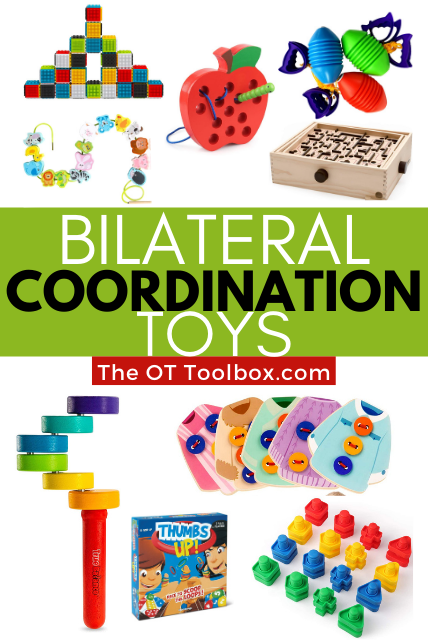
Bilateral integration
Bilateral coordination in functional tasks makes up much of our day! Think of all of the other areas where you are using both hands or both sides of the body at the same time: getting dressed, tying shoes, cooking, typing, holding a book while reading, pouring a glass of water…the list could go on and on!
Read about bilateral integration in the cross crawl exercise resource.
This integrated use of both sides of the body can be developed through play.
Using both sides of the body together is a skill needed for many tasks: writing with a pencil with one hand while stabilizing paper with the other hand is one such activity.
Another bilateral coordination task is cutting with scissors with one hand while holding and manipulating paper with the other hand.
For children with difficulty in crossing midline, or using integrated bilateral skills, using toys in play is an effective way to work on and nurture this skill.
Looking for a toy to work on bilateral coordination to add to your gift giving this holiday season? Today we are covering ways to build bilateral coordination skills using toys and everyday items. We also have another giveaway to share today. This time it’s a fine motor toy that promotes a variety of sills, bilateral integration being one of them. I wanted to highlight this as a toy for building bilateral coordination because as we know, promoting this skill is a valuable building block to other tasks such as handwriting, cutting with scissors, self-care tasks, and more.
Working on bilateral coordination in play is a means and a strategy for building this essential skill. So, why is bilateral coordination so important? And what exactly does bilateral coordination mean?
DIY Bilateral Coordination Toys
We’ve shared quite a few bilateral coordination toys and DIY activities here on this site in the past.
A bilateral coordination lacing plate is a DIY toy and activity that can be used to work on coordinated use of both hands with a variety of themes.
Using puzzles and games that you already have with an extra special addition can be a great way to work on bilateral coordination with puzzles.
Play dough and sensory doughs are fun ways to play while working on skills like bilateral coordination and other motor skills.
Stickers are an easy way to work on bilateral coordination and can be used in the classroom, clinic, or home and in combination with obstacle courses and other motor activities.
Pegboards (both DIY and store-bought versions), are a fantastic way to work on bilateral coordination in play and in developing visual motor skills and coordination.
DIY pick-up sticks are a fun way to address bilateral integration and coordinated use of both hands together.
Making DIY lacing cards are a fun way to work on bilateral coordination. Making the lacing cards is part of the fun.
Miniature rhythm sticks can be a musical and creative way to encourage bilateral coordination.
Lock and keys games like with this DIY lock and key activity makes fine motor development an out of the box way to work on skills kids need for independence and instrumental activities of daily living.
Bilateral Coordination Toys
There are many bilateral coordination toys on the market as well. Let’s take a look at some toys and games that you can add to your therapy toolbox.
Amazon affiliate links are included below.
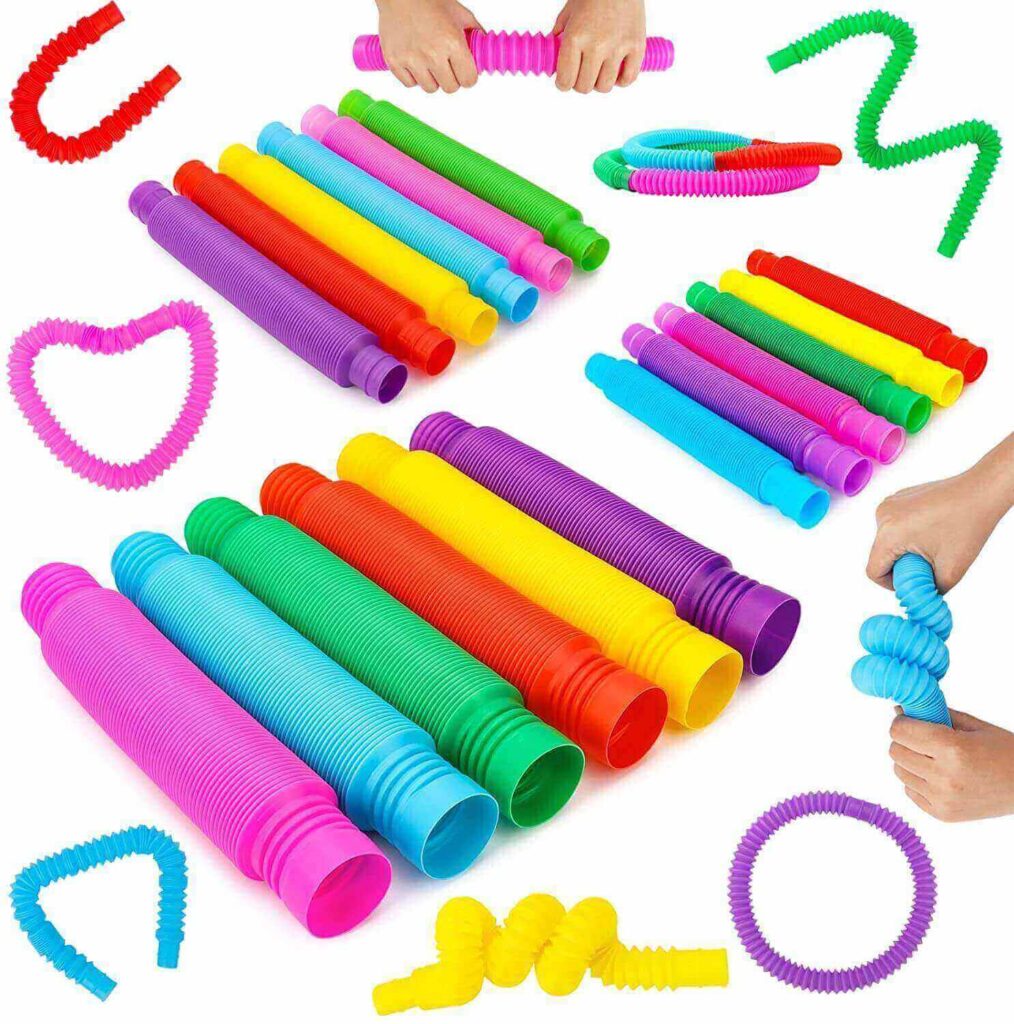
Pop Tubes Toy for Bilateral Coordination– (affiliate link) Pop tubes can be used in many ways to work on bilateral skills. Use them for a fine motor bilateral coordination task, or use them to work on a large scale or small scale. Wrap one around a wrist and build off of that tube. Or create a chain of tubes. Hold one and drop objects through the tube and into a container. How will you use this bilateral coordination toy?
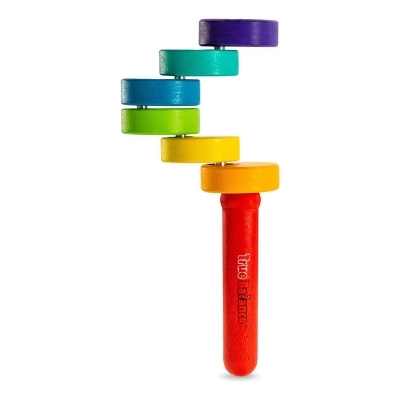
TruBalance Bilateral Coordination Toy– (affiliate link) This toy requires both hands as well as the eyes to challenge balance, coordination, and bimanual skills. Kids can work with this toy while sitting, standing, or in more challenging positions. Try incorporating couch cushions for a balance activity. Use this toy in a bilateral coordination obstacle course. Kids can use the pieces in a scavenger hunt type of activity where the parts are scattered at various levels and positioning, allowing the child to crawl, climb, walk, or squat while balancing the toy. The options go on and on!
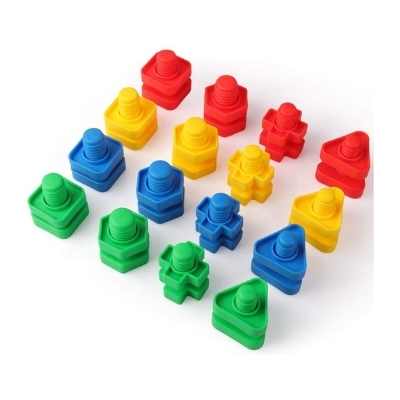
Nuts and Bolts Bilateral Coordination Toy– (affiliate link) This nuts and bolts activity is great for developing fine motor skills as well as bilateral coordination by requiring the child to use one hand to manipulate the parts while the other hand acts as a stabilizer. This is a nice way to develop skills needed for tasks like handwriting, pouring, stabilizing, cooking, etc.
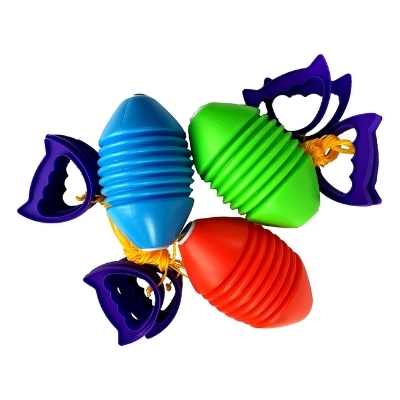
Zoom Ball– (affiliate link) This classic toy is such a great way to work on many skills: bilateral coordination, core strength, shoulder stability, visual convergence, motor planning, and coordination. Just like the TruBalance toy, a zoom ball can be used in different positions to challenge balance and vestibular input: Try using the zoom ball in sitting, standing, kneeling, standing on couch cushions, a slant…again, the options are limitless! Use our favorite zoom ball games to get started.
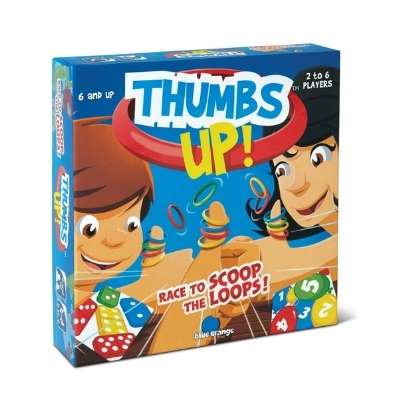
Thumbs Up Game– (affiliate link) This bilateral coordination game requires players to place rings on their thumb in a “thumbs up” position while they race to scoop and find the correct combination of colored rings to add to their thumb. It’s a fun racing game that builds visual perceptual skills too: figure ground, visual discrimination, visual memory, as well as the visual processing skill of scanning.
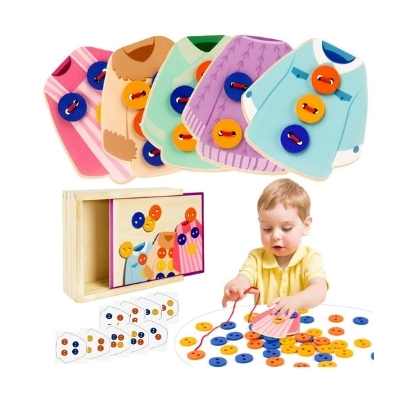
Lacing Buttons– (affiliate link) There is no doubt about the power of lacing cards when it comes to developing bilateral coordination skills. However, this lacing buttons activity takes it up a notch with the eye-hand coordination and visual processing skills. Kids can lace buttons onto wooden shirt pieces while building bilateral skills, fine motor skills, and eye-hand coordination. However, the set also includes puzzle cards that ask the child to lace on colored buttons in specific order so it matches the cards. What a workout in visual processing skills, too!
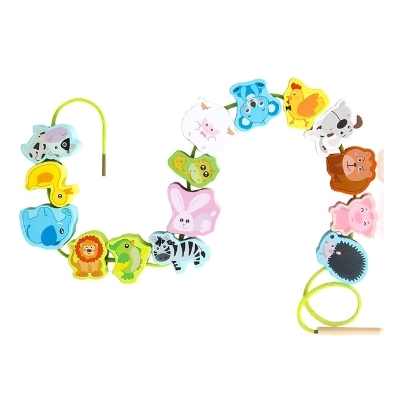
Animal Lacing Beads– (affiliate link) These lacing beads are chunky wooden animals that help kids develop bilateral coordination, eye-hand coordination, fine motor skills, and visual perceptual skills. As an occupational therapist, I am drawn to this toy because of the different animals that could be used in sequencing activities, sensory bins, pretend play, stacking activities, and so much more.
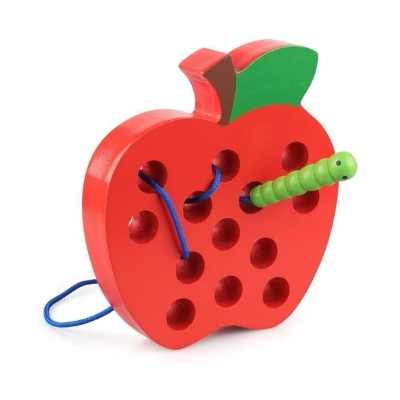
Wooden Lacing Apple– (affiliate link) This lacing puzzle challenges bilateral coordination skills and can be used to work on eye-hand coordination, tripod grasp, and motor planning. Use this activity to help with stabilization as well.
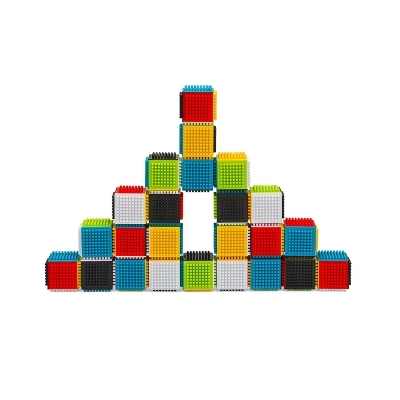
Press and Stay Blocks– (affiliate link) These building blocks require bilateral coordination with a press so they stay, helping kids to develop bilateral coordination and get proprioceptive input to push them together and then take them apart. Building blocks are a great way to build fine motor skills and visual perceptual skills, and these are a great addition to your therapy toolbox collection.
Labyrinth Game– (affiliate link) This maze game is a favorite in our house, and a tool for building bilateral coordination and visual perceptual skills too. Kids need to manipulate two knobs at the same time and coordinate visual information with one hand or the other…or both. It’s a brain building challenge that involves both sides of the body. Challenge kids to do this activity in a kneel or while standing on their knees at a low table to challenge balance and offer proprioceptive input as well.
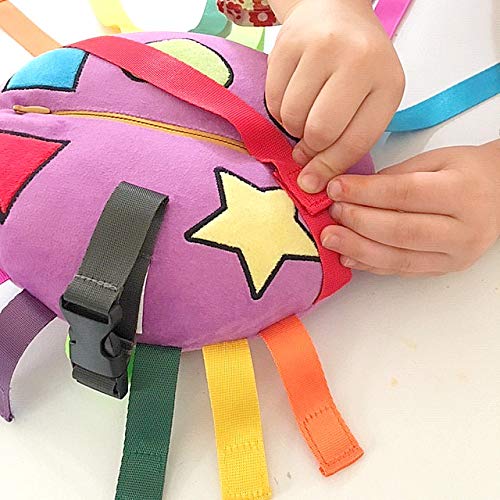
Octi Buckle Plush Toy with Hook and Loop Straps– (affiliate link) This play toy is a strategy to encourage development of fine motor skills, problem solving, color matching, coordination, and more. This stuffed play buddy is a toy that promotes development of many skills, bilateral coordination being one of them.
Using toys that double as quiet time activities, busy bags, or travel toys…all while working on skills is what makes toys like the buckle plush toy a therapist-approved toy. A buckle toy, with bright colors, shapes, straps, and zipper pouch will provide countless hours of recognition activities, brain building games and development puzzles. Your little one will stay busy counting the number of straps, connecting them together, pulling them apart, and starting over again. Kids can hide small items and treasures in the zip pouch, then unzip it later and get excited over their discovery!
More Bilateral coordination activities
Amazon affiliate links are included below.
- Melissa & Doug Pop Blocs Farm Animals
- Brain Development Bilateral Coordinate Training Set
- Nuts and Bolts Toys
- Creative Construction STEM Building Toys
- Brain Flakes Interlocking Plastic Disc Set
Some of the smartest and most creative folks I know are the readers of The OT Toolbox. I asked readers to tell me sensory strategies they personally love and use to address sensory modulation. Scroll through the comments…you might just find some new sensory strategies that will work for you! Hopefully we can learn from one another!
Also, check out these other soy suggestions based on therapeutic development through play.
- Fine Motor Toys
- Gross Motor Toys
- Pencil Grasp Toys
- Toys for Reluctant Writers
- Toys for Spatial Awareness
- Toys for Visual Tracking
- Toys for Sensory Play
- Bilateral Coordination Toys
- Games for Executive Functioning Skills
- Toys and Tools to Improve Visual Perception
- Toys to Help with Scissors Skills
- Toys for Attention and Focus
Printable List of Toys for Bilateral Coordination
Want a printable copy of our therapist-recommended toys to support bilateral coordination?
As therapy professionals, we LOVE to recommend therapy toys that build skills! This toy list is done for you so you don’t need to recreate the wheel.
Your therapy caseload will love these BILATERAL COORDINATION toy recommendations. (There’s space on this handout for you to write in your own toy suggestions, to meet the client’s individual needs, too!)
Enter your email address into the form below. The OT Toolbox Member’s Club Members can access this handout inside the dashboard, under Educational Handouts. Just be sure to log into your account, first!

Colleen Beck, OTR/L has been an occupational therapist since 2000, working in school-based, hand therapy, outpatient peds, EI, and SNF. Colleen created The OT Toolbox to inspire therapists, teachers, and parents with easy and fun tools to help children thrive. Read her story about going from an OT making $3/hour (after paying for kids’ childcare) to a full-time OT resource creator for millions of readers. Want to collaborate? Send an email to contact@theottoolbox.com.







176 thoughts on “Bilateral Coordination Toys”
popping bubbles with both hands
I love to have students work on bilateral coordination skills to string letter beads to form their name!
Took the idea form a videogame. Use two different ball set. Assign one type or color for one side for example white ball for the right side and black for the left. Then when I throw a white ball at them they are only allowed to use their right arm or right foot to catch it or bounce it off.
making friendship chains is always super popular!
Stringing beads, nut/bolt type toys, or link/chain type toys!
Any assembly toy such as K’nex, Legos, Magnetics etc. ….using picture instructions will promote independent play.
Using 2 feet together to keep a balloon in the air.
I make seasonal paper plates that require clothespin- spider/legs, turkey/featers, flower, snoflake, Santa’s beard, reainbo to match paint sample colors, ice cream cone with sprinkles, etc. i also have them stand on a balance board while they complete the ideal cross midline activity- especially with lots of turkey feathers they painted with dor markers. I also have a variety a clothespins from easy plastic to plastic clamps or paper fasteners that are hard. I even had wide handled plastic one for different squeeze/grasp…
I like this item for the colors and counting and as I often use a bag or hide inside item for an object to feel and describe and this would make a fun passable for that or for a gross motor game like overhead and between legs, etc…
It would be so pr=erfect for so many ythings!
Assembly toys and beading
We use puzzles, lacing cards and playdough daily in our class.
We’re fans of lacing in this house! Especially when the beads are shaped like dinosaurs!
Living in the desert, I had the preschoolers I work with use tweezers to help pull cactus needles from a stuffed animal who “went hiking and got them stuck”. They enjoyed it.
zoomball!
There are so many ways to address bilateral hand coordination. I love to do beading and lacing activities, as well as incorporating crafts that include cutting and tearing paper.
Cutting snips on the edges of post it notes!!!
Play dough , stringing beads , nuts and bolts , pegs/pegboards and stickers
Moving a marble in a fog of 8 toy. Don’t remember the name but is an excellent bilateral, eye hand coordination and motor planning activity.
Playing catch/ ball games. Hitting a baseball bat, stringing beads, lacing, and various other board games- my kids loved jumping monkeys!
music and movement are my go to.
Love zoom ball for bilateral integration and coordination.
I like using different size tongs to pick up different kids of items, like ping pong balls,, cotton or marbles.
Bubbles are my go too!
Containers…all types all sizes
Playing with our forward pass game
Play doh and drumming!!
we use rubber bands- on geo boards or to wrap around a variety of objects like cans or blocks
Patty cake or other hand clapping games with parents or peers
Love Geoboards, Pop the pig/Pop up pirate, and zoom ball!
Stringing beads, cutting play dough and paper, picking up objects and handing them to opposite hand to place in target.
I love having my kids do animal walks (they love it too!), and I also like any games that involve using two hands to catch/throw a ball, using play dough to practice cutting and other bimanual coordination activities.
I like to incorporate arts and craft activities to work on bilateral coordination, lacing paper plates or cutting out things to make something seasonal, stringing things.
My younger students enjoy playing with noise make tubes as a bilateral coordination activity. We pull them apart and push them back together using both hands, put little toys into the “tunnel” the tubes make, and make the tubes into steering wheels and different shapes.
I like to play fine motor games such as travel connect four for in-hand manipulation skills.
I love having kids maintain a crab walk position while using one hand to pick up a stuffed toy, cross over their chest and drop it in a bucket on the opposite side of them.
I let my daughter unscrew the tube of toothpaste and squeeze it out with one hand while holding the toothbrush in the other (she has small hands). We also like stickers.
Stringing beads, play dough, rapper snapper, putty with beads inside
I love to string beads, play doh, and lacing activities to promote bilateral hand coordination.
Great toy! I love using stickers and velcro
I love Zoom Ball!
Hey just wanted to give you a quick heads up. The words in your post seem to
be running off the screen in Safari. I’m not sure if this is a format issue or something to do with web browser compatibility
but I thought I’d post to let you know. The design look
great though! Hope you get the issue resolved soon. Cheers
My kiddos always enjoy playing catch and Squigz for bilateral coordination practice.
Balloon toss, bead threading for bracelets, cutting out shapes, painting ornaments, making dough
I love using MeMoves with my students to help with this area.
So many ideas to choose from! I’ve used zoom ball with kids from 4 to 99 yo. The oldest kids love it just as much as the youngest. Of course I’m incorporating more than bilateral integration into the activity….eye hand, strength, endurance, breathing, etc.
Stringing beads onto pipe cleaners!
Most recently my kids liked placing matching beads on a pipe cleaner tree. The tree wasn’t stable enough so it required a second hand to stabilize while they placed beads with dominant hand. Also love a pop tube for bilateral hand work. Even my kids who don’t like loud sounds will engage with a pop tube!
Zoomball and Super Tubes are my go-to bilateral coordination activities!
Beads, lacing and zoom ball.
zoom ball, cutting, bubbles
I love to use building toys such as Junior Mechanix or Legos to work on bilateral coordination skills. Cutting, stringing beads and lacing are all great as well
Zoom ball, balloon activities, cutting slime, just to name a few!
I love working bilateral coordination into an obstacle course!
I love doing obstacle courses. Kids love them and you can incorporate so many bilateral coordination activities!
building with Duplo and Lego
Followed on Instagram
Shoe tying (when appropriate) is my favorite bilateral integration activity!
I love using lacing and stringing beads during my sessions!!
Cutting, ‘feed’ a tennis ball with a slit cut into it for a mouth, stringing beads, opening containers (hide fun things inside!) 🙂
With all the recent holidays, we have been doing a lot of craft activities that require cutting, gluing, coloring. Great to work on fine motor, bilateral coordination, and executive function to follow the directions. Today we are cutting green paper strips and rolling them together to form a Christmas tree.
Cut/color/paste activities and ADL vests/dolls
I love doing gross motor sequences that work on bilateral coordination- hitting a balloon or throwing a ball or using two hands to pull self on the scooter board. I also love doing pop bead people and pop bead animals.
I like having the kids pop bubbles by clapping hands together
I like having the kids clap their hands together to pop bubbles
I like to use large pop beads for bilateral hand practice.
I love cross body high fives. Children get really excited to celebrate their accomplishments, and you can cross the midline, use right left and both hands together to do a variety of types of high fives.
Tearing paper to make a craft project and using pop beads are some of my favorites for hand strengthening and using both hands together.
So many favorites! Stringing beads, feeding a tennis ball mouth (I call mine Fred), pop up pirate game, stickers, stabilizing containers with one hand while placing objects in with the other…
Stringing beads, Legos, playdoh, and playing catch with a ball or stuffed animals.
My son loves Lego so I like to encourage different activities that also incorporate learning such as building a bridge one of his toys can be the troll under, creating the first letter of his name, building a marble maze or a water chase. Both of my kids love stringing beads from my jewelry making supplies; and my daughter enjoys play dough so I like to encourage its use with her various role play games.
Zoomball, playdough, lego…
I use marching cross crawls as a transition activity.
Stringing beads on our seasonal “planters” in pots, and pop-bead necklaces (there are so many different kinds now!), and cross marching!
I enjoy using lacing cards and blocks to thread
I love using a zoomball, accordian tubes, stringing different kinds of beads, Mr. Mustache Man (tennis ball with slit cut into it; kids have to squeeze the mouth open with 1 hand & feed with other hand), different gross motor games/obstacle courses, construction toys (especially Zoobz), and many more activities. 🙂
My favorite bilateral coordination activity is a toy tool kit. The client needs to stabilize with one hand and functionally use the other hand. This is great for handwriting and cutting!
I will be integrating arts and crafts activities into my small group sessions as they enjoy using the art supplies I have available because it provides an additional method for expressing thoughts and feelings. The ideas that were presented in the article are ones that I have recently been introduced to and am eager to implement!
Can’t wait to try some these great ideas!
For little guys I love pop beads and poptoobs, for older kiddos I like using a zoomball!
Climbing ladders/nets – it’s bilateral involving upper and lower body with lots of core work and motor planning as well.
This fine motor toy looks so fun!
I do a lot of bilateral work by keeping my fine motor tasks in bags that need to be buttoned and unbuttoned—some small buttons, some bigger.
With my youngest kids, I like to have them put items inside a container and stabilize the container with their helper hand to begin working on bilateral integration. I also like to use lacing and stringing activities to work on bilateral integration.
I use pop beads. lacing, and stringing beads to work on bilateral coordination.
We love construction toys, bouncing the ball and catching it and cutting with scissors
Accordion tubes, cross body movements, zoom ball.
I like using juggling/dancing scarfs and rubber band activities
Zoomball is one of my favorite activities
Different size container play- open and close, in/ out
Cooking activities- shake/stir/ pour
Zoomball!!
I like to use tape to address bilateral coordination. Tearing tape for a project or I wrap up small toys that they have to remove the tape from.
Bubble wrap and the air filled packing pillows. Steamers and music
my favorite bilateral coordination activity is stringing beads. I used to have a play sewing set complete with a large plastic needle, spool, and buttons. Many children enjoy stringing fruit loops to make a necklace. Having a take home product is beneficial.
I like to use stickers or hole punches to work on bilateral skills.
Simon says using Brain Gym activities! The kids don’t even know they are exercising and working their brains!
I like to play zoomball
Zoom ball and lacing old Christmas cards that I have laminated and hole punched are 2 of my favourites.
I love using scooter boards prone, having the child maneuver using alternating arms, platform swing prone and use arms to turn swing and pick up items to place or throw, aquatics for paddling, rowing, etc., and then seated fine motor activities and crafts with incorporate bilateral skills.
Making friendship bracelets with beads and pipe cleaners are always super popular.
My favorite bilateral coordination strategy is play dough. It requires a whole lot of bilateral coordination to roll the dough, push down the shape, and carefully pull it out.
I love using everyday objects to promote bilateral coordination – nuts and bolts, lacing, stringing items, etc
I like to have students participate in cooking activities to enhance bilateral coordination for functional tasks like holding the bowl while stirring, opening containers, etc.
pipecleaners/beads; sticker activities; catching;
Theraputty! Not only works on bilateral motor coordination, but hand and finger strength too!
I love doing songs with hand motions that require students to use both sides so fun and alerting
Zoomball!!
I like to play monkey see monkey do where we take turns being the lead “monkey” and the others copy. It takes the auditory component away from Simon says.
Placing the paper on a wall so the student has to hold it up with one hand while using the other to write or draw.
I use tongs and picking up small objects
We play kerplunk using both hands. It’s not easy.
I like bilateral coordination activities such as beading and lacing activities, as well as incorporating crafts that include cutting and tearing paper.
Using a hole punch to make a pattern on the edge of a paper plate and then lace a string through it!
Paint sticks with velcro – attach/remove buttons to sort; attach letters to work on their name, etc
I like using Theraputty and pop tubes for bilateral coordination as well as doing exercises like push ups and jumping jacks.
I love having the kids lie down in the hammock swing and use their arms to pick up bean bags then throw the bean bags to me. This works on both bilateral coordination and proximal strength. Plus the kids love it!
I like making put in tasks using smaller containers they have to hold the container while putting in different sized holes. Holding a wooden spoon and putting on pool noodles for lower level stringing.
I love using pop up pirate. the swords are just stuck i n enough that you need two hands to stabilize the barrel. I also like to use these pop bead necklace sets I found at my local grocery store. Its sort of like pop beads with tubes.
Legos are highly favored in our home both by kiddo and me.
I love Zoomball, theraputty activities, bubbles, balloons, and beading / lacing activities!!
Catch games using both hands and a container!
Popbeads. They come in so many different sizes now you can use for all ages and stages in development.
building LEGO og plusplus, making puzzles
Making a picture/scene with Stickers, especially scented stickers, is so much fun for my kids.
Stringing beads, nuts,and bolts, making fidgets
Threading beads to make bracelets.
Beading, lacing cards, cutting activities, building with Lego.
Slinky Pop Toobs! The kids LOVE them and a bonus- the auditory feedback makes them giggle!
i love doing crafts specifically those involving cutting, glueing and placing small objects working on symmetrical and asymmetrical bilateral movements !
My kids and I love playing with dough and catching/throwing balls and ballons with both hands. Also, it is pretty fun stringing beads, macaroni and whatever really fits the string!
Wheelbarrow walk-outs then having to pick up toys that are spread out on the floor and put them in a bucket.
I love using stickers for all sorts of activities. It is so motivating!
Stringing beads, pop beads, Velcro tennis
I like to clothespin games for matching, going on a hunt holding a bucket or bag in one hand and picking up with other hand, games the require pulling objects apart or putting objects together to build something.
I love using Squigs. My students find it really fun to build together. A strategy I use to work on crossing midline is I have the student put one sock on their hand and leave the other on the opposite foot. They then must touch the bare foot and hand together and than the socks together. Works so well!
Picking up “groceries” and putting them in a play shopping cart
Putting favorite snack in a small jar with a lid to unscrew or for a child that doesn’t want to put things together, have them help you undo legos or other connecting toy to put them away.
Beading and lacing activities.
stringing beads and pop tubes!
Love the zoom ball!
I need some ideas!
rolling out play dough and zoom ball 🙂
My kid loves gross motor activities..tossing balloons back n forth… climbing up steps and on chairs… Bubbles… Crawling…
Our little school is starting to use sensory items in all the classes as we learn more about how they help many students.
Finger rhymes and songs!
Love squigz, nuts and bolts, and using stencils!
Bopping balloons to keep them in the air. It can be one kid, more taking turns, over a net, or keeping it away from each other. For more difficulty, older kids have to use a different hand or foot than the last one they used. Balloons fall slowly so there is more time to coordinate and see where the balloon is going.
Manips – legos, magnatiles, playdough, wikisticks, tinkertoys, stringing beads, cutting…
My favorite bilateral coordination activity is peeling stickers requires both hands: hold the sheet with one hand and peel with the other hand. Kids have to use both hands to work and later paste them where we tell them to. I love to see their exciting faces and how they enjoy when they are doing this activity, not knowing they are developing lots of areas with this!
My favorite bilateral coordination activity is lying prone on a swing and then using both hands to climb up a rope! So much fun! I also love rythm, clapping, and movement activities to address bilateral coordination.
Stringing and lacing, cutting activities, play doh. Going to try some of the activities others have mentioned!
I love using ADLs and IADLs (cooking ) to work on bilateral coordination when possible. I also love playdoh, playing ball, and lacing beads:)
Bubble wrap is GREAT. You can pop with your hands and feet.
Zoom ball, dealing/playing cards, building block towers. We also have made alphabet plates and they use to hands to slide a penny from one letter to another to do abc’s or spell their name, spelling words.
play dough, stickers, pop toys, stringing beads
I love using pop tubes! They are one of my favorite toys!
We string beads, puzzles and play doh almost daily. The kids really enjoy it and some learned how to use these tools for the first time in class.
I use old game pieces, like Battleship and The Game of Life and the students place the tiny tokens into the ship or car. Such a great fine motor and eye hand coordination activity while using both hands.
Huge issue in my school is using two hands to complete tasks! These are all great! Love these! So cute and my students would be so engaged.
The balance bilateral toy is a true challenge for all! Such a great tool to have.
Pop tubes are a hit with my elementary kids and a fun way to get hands ready for fine motor tasks!
As a school-based OT, I like to use pop beads and geoboards for my older students and do fun crafts with the younger ones- using glue, scissors, clothespins, tissue paper etc.
Stickers are my favorite!!!
Have and love Zoom ball! It’s a favorite!
The Thumbs UP game looks great!!
Lacing is a great bilateral integration skill. Usually, students have not done a lot of it and it is interesting them. Beginning fastener skills are great too. Doing any repetitive activity is usually calming for students.
HI there. Im out west and it is just after midnight here. I just learned about the OT Toolbox! Amazing site. I love bilateral coordination activities. This week, one activity the children will do is making beaded candy canes -beads on pipe cleaners. Cheers!
Comments are closed.